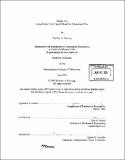| dc.contributor.advisor | David Gossard. | en_US |
| dc.contributor.author | Doering Heather A. (Heather Anne) | en_US |
| dc.contributor.other | Massachusetts Institute of Technology. Dept. of Mechanical Engineering. | en_US |
| dc.date.accessioned | 2006-05-15T20:35:27Z | |
| dc.date.available | 2006-05-15T20:35:27Z | |
| dc.date.copyright | 2005 | en_US |
| dc.date.issued | 2005 | en_US |
| dc.identifier.uri | http://hdl.handle.net/1721.1/32863 | |
| dc.description | Thesis (S.B.)--Massachusetts Institute of Technology, Dept. of Mechanical Engineering, 2005. | en_US |
| dc.description | Includes bibliographical references (leaf 23). | en_US |
| dc.description.abstract | A foot-scale model of an icosahedral virus capsid, as opposed to a helical capsid shape, was modeled in preparation for manufacture for educational use. We chose to model the icosahedral virus capsid for manufacture because understanding the structure of this type of capsid is of biological importance, the icosahedral structure is well-established, and because the icosahedral structure and geometry is representative of many viruses, it is important to virology. A small icosahedral virus capsid consists of 60 identical proteins. Larger capsids are formed by adding quasi-equivalent proteins, with 60 copies of each unique protein. Our model calls for the creation of an injection mold for one unique protein. 60 parts should snap together with one another after manufacture to create an icosahedron. The protein was modeled using the SolidWorks computer aided drawing (CAD) software. The CAD model could then be converted to a file that enables us to mill a two part mold out of aluminum blocks. This aluminum mold will then be used to injection mold parts made out of polypropylene. The parting lines and sprue of the final parts will be cleaned up and then assembled to complete the model. This thesis details the specifics of the modeling of this protein, focusing on the design of the attachment method for capsid assembly from a single injection mold. | en_US |
| dc.description.statementofresponsibility | by Heather A. Doering. | en_US |
| dc.format.extent | 23 leaves | en_US |
| dc.format.extent | 2274056 bytes | |
| dc.format.extent | 2272193 bytes | |
| dc.format.mimetype | application/pdf | |
| dc.format.mimetype | application/pdf | |
| dc.language.iso | eng | en_US |
| dc.publisher | Massachusetts Institute of Technology | en_US |
| dc.rights | M.I.T. theses are protected by copyright. They may be viewed from this source for any purpose, but reproduction or distribution in any format is prohibited without written permission. See provided URL for inquiries about permission. | en_US |
| dc.rights.uri | http://dspace.mit.edu/handle/1721.1/7582 | |
| dc.subject | Mechanical Engineering. | en_US |
| dc.title | Design of a large-scale virus capsid model for educational use | en_US |
| dc.type | Thesis | en_US |
| dc.description.degree | S.B. | en_US |
| dc.contributor.department | Massachusetts Institute of Technology. Department of Mechanical Engineering | |
| dc.identifier.oclc | 62587644 | en_US |
